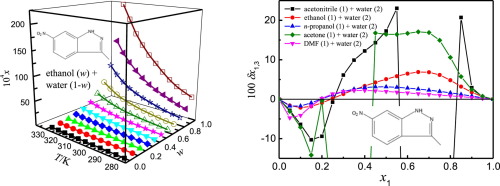当前位置:
X-MOL 学术
›
J. Chem. Thermodyn.
›
论文详情
Our official English website, www.x-mol.net, welcomes your
feedback! (Note: you will need to create a separate account there.)
3-Methyl-6-nitroindazole in some aqueous co-solvent mixtures: Solubility determination, preferential solvation and solvent effect analysis
The Journal of Chemical Thermodynamics ( IF 2.2 ) Pub Date : 2020-05-01 , DOI: 10.1016/j.jct.2020.106066 Wanxin Li , Ali Farajtabar , Rong Xing , Yiting Zhu , Hongkun Zhao , Rongguan Lv
The Journal of Chemical Thermodynamics ( IF 2.2 ) Pub Date : 2020-05-01 , DOI: 10.1016/j.jct.2020.106066 Wanxin Li , Ali Farajtabar , Rong Xing , Yiting Zhu , Hongkun Zhao , Rongguan Lv

|
Abstract The equilibrium solubility of 3-methyl-6-nitroindazole in co-solvent mixtures of acetonitrile (1) + water (2), ethanol (1) + water (2) and n-propanol (1) + water (2) is reported. Experiments were performed by using the saturation shake-flask technique at temperature range from 278.15 to 328.15 K. The maximum solubility value was observed in neat acetonitrile (ethanol or n-propanol) for each co-solvent mixtures. By using the Jouyban-Acree model, the 3-methyl-6-nitroindazole solubility was well correlated obtaining RAD values smaller than 4.50% and RMSD values smaller than 3.36 × 10−4. Quantitative values for the local mole fraction of acetonitrile (ethanol, n-propanol, DMF or acetone) and water around the 3-methyl-6-nitroindazole were computed by using the Inverse Kirkwood–Buff integrals method applied to the solubility data. 3-Methyl-6-nitroindazole was preferentially solvated by water in water-rich compositions; while within co-solvent-rich and intermediate compositions, 3-methyl-6-nitroindazole is preferentially solvated by acetonitrile (ethanol, n-propanol, DMF or acetone) in the acetonitrile (ethanol, n-propanol, DMF or acetone) + water mixtures. The experimental solubility data were correlated by Kamlet and Taft linear solvation energy relationships to examine the main factors describing solvent effect. The results showed that the change in cavity formation energy over the composition played the main role on the solubility variation of 3-methyl-6-nitroindazole in all aqueous mixtures.
中文翻译:

某些水性共溶剂混合物中的 3-甲基-6-硝基吲唑:溶解度测定、优先溶剂化和溶剂效应分析
摘要 3-甲基-6-硝基吲唑在乙腈 (1) + 水 (2)、乙醇 (1) + 水 (2) 和正丙醇 (1) + 水 (2) 的共溶剂混合物中的平衡溶解度为报道。使用饱和摇瓶技术在 278.15 至 328.15 K 的温度范围内进行实验。在纯乙腈(乙醇或正丙醇)中观察到每种共溶剂混合物的最大溶解度值。通过使用 Jouyban-Acree 模型,3-甲基-6-硝基吲唑溶解度具有良好的相关性,获得小于 4.50% 的 RAD 值和小于 3.36 × 10−4 的 RMSD 值。3-甲基-6-硝基吲唑周围的乙腈(乙醇、正丙醇、DMF 或丙酮)和水的局部摩尔分数的定量值是通过使用应用于溶解度数据的逆柯克伍德-布夫积分方法计算出来的。3-甲基-6-硝基吲唑在富水组合物中优先被水溶剂化;而在富含共溶剂和中间体的组合物中,3-甲基-6-硝基吲唑优先被乙腈(乙醇、正丙醇、DMF 或丙酮)溶解在乙腈(乙醇、正丙醇、DMF 或丙酮)+水中混合物。实验溶解度数据通过 Kamlet 和 Taft 线性溶剂化能关系相关联,以检查描述溶剂效应的主要因素。结果表明,空腔形成能随组合物的变化对 3-甲基-6-硝基吲唑在所有水性混合物中的溶解度变化起主要作用。3-甲基-6-硝基吲唑在乙腈(乙醇、正丙醇、DMF 或丙酮)+水混合物中优先被乙腈(乙醇、正丙醇、DMF 或丙酮)溶剂化。实验溶解度数据通过 Kamlet 和 Taft 线性溶剂化能关系相关联,以检查描述溶剂效应的主要因素。结果表明,空腔形成能随组合物的变化对 3-甲基-6-硝基吲唑在所有水性混合物中的溶解度变化起主要作用。3-甲基-6-硝基吲唑在乙腈(乙醇、正丙醇、DMF 或丙酮)+水混合物中优先被乙腈(乙醇、正丙醇、DMF 或丙酮)溶剂化。实验溶解度数据通过 Kamlet 和 Taft 线性溶剂化能关系相关联,以检查描述溶剂效应的主要因素。结果表明,空腔形成能随组合物的变化对 3-甲基-6-硝基吲唑在所有水性混合物中的溶解度变化起主要作用。
更新日期:2020-05-01
中文翻译:

某些水性共溶剂混合物中的 3-甲基-6-硝基吲唑:溶解度测定、优先溶剂化和溶剂效应分析
摘要 3-甲基-6-硝基吲唑在乙腈 (1) + 水 (2)、乙醇 (1) + 水 (2) 和正丙醇 (1) + 水 (2) 的共溶剂混合物中的平衡溶解度为报道。使用饱和摇瓶技术在 278.15 至 328.15 K 的温度范围内进行实验。在纯乙腈(乙醇或正丙醇)中观察到每种共溶剂混合物的最大溶解度值。通过使用 Jouyban-Acree 模型,3-甲基-6-硝基吲唑溶解度具有良好的相关性,获得小于 4.50% 的 RAD 值和小于 3.36 × 10−4 的 RMSD 值。3-甲基-6-硝基吲唑周围的乙腈(乙醇、正丙醇、DMF 或丙酮)和水的局部摩尔分数的定量值是通过使用应用于溶解度数据的逆柯克伍德-布夫积分方法计算出来的。3-甲基-6-硝基吲唑在富水组合物中优先被水溶剂化;而在富含共溶剂和中间体的组合物中,3-甲基-6-硝基吲唑优先被乙腈(乙醇、正丙醇、DMF 或丙酮)溶解在乙腈(乙醇、正丙醇、DMF 或丙酮)+水中混合物。实验溶解度数据通过 Kamlet 和 Taft 线性溶剂化能关系相关联,以检查描述溶剂效应的主要因素。结果表明,空腔形成能随组合物的变化对 3-甲基-6-硝基吲唑在所有水性混合物中的溶解度变化起主要作用。3-甲基-6-硝基吲唑在乙腈(乙醇、正丙醇、DMF 或丙酮)+水混合物中优先被乙腈(乙醇、正丙醇、DMF 或丙酮)溶剂化。实验溶解度数据通过 Kamlet 和 Taft 线性溶剂化能关系相关联,以检查描述溶剂效应的主要因素。结果表明,空腔形成能随组合物的变化对 3-甲基-6-硝基吲唑在所有水性混合物中的溶解度变化起主要作用。3-甲基-6-硝基吲唑在乙腈(乙醇、正丙醇、DMF 或丙酮)+水混合物中优先被乙腈(乙醇、正丙醇、DMF 或丙酮)溶剂化。实验溶解度数据通过 Kamlet 和 Taft 线性溶剂化能关系相关联,以检查描述溶剂效应的主要因素。结果表明,空腔形成能随组合物的变化对 3-甲基-6-硝基吲唑在所有水性混合物中的溶解度变化起主要作用。











































 京公网安备 11010802027423号
京公网安备 11010802027423号